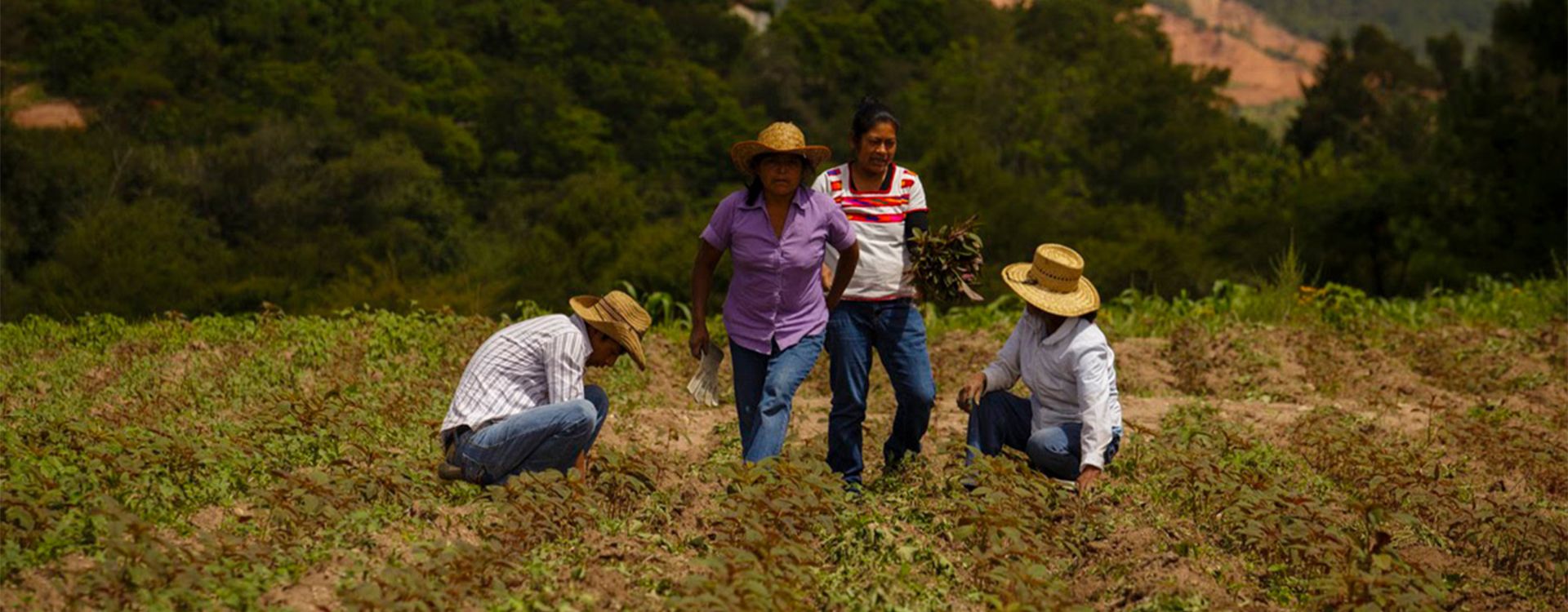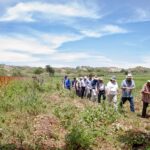«I want my daughter to go to school and learn but it is also just as important that she works in the field and learns to love the land.».
– Bibiana, Farmer in the Mixteca Regional Amaranth Network


«I want my daughter to go to school and learn but it is also just as important that she works in the field and learns to love the land.».
– Bibiana, Farmer in the Mixteca Regional Amaranth Network
Using agroecological practices goes hand in hand with Puente’s mission to contribute to food sovereignty.
Agroecology is the act of using natural cycles and processes along with appropriate technologies to create self-sustaining farming systems that will eliminate the need for harmful chemical inputs, that will recycle nutrients through the use of organic fertilizers, and that diversify crops. Agroecology reduces input costs, provides autonomy from corporations and governmental influence, diversifies income opportunity, and yields diverse produce for a more complete nutritional impact.
Agroecology is not just a farming technique. It is a socioeconomic practice that values people and the environment over profits. It values equity, solidarity, and responsible production and consumption, creating space for indigenous people as well as women, people of color, and youth to have a voice and to take on leadership roles.
In the fight for food sovereignty, agroecology is a transformational tool that provides a new model of production, distribution, and consumption outside of industrialized farming.
For every peso paid in industrial food, we pay two pesos in damage to our health and environment.
The average age of the smallholder farmer in Mexico is 67 years old. As the youth of Mexica and the world realize the damage that has been done to the environment, agroecology offers an opportunity to repair the soil and clean water systems as well as create economic opportunity in rural communities once again. Puente works to empower youth leaders to understand that there is hope, value, and promise in working the land.
diversity
synergies
efficiency
resilience
recycling
collaboration and knowledge exchange
culture and food traditions
responsible governance
circular and solidarity economy
the value of people and community
«In the two years since I started to plant all of my crops ecologically, the grains of the corn and of the amaranth are fat, beautiful and wonderfully unpredictable.»
– Don Manuel, Farmer, Mixteca Amaranth Network
Mexico is the center of origin and diversification of the amaranth seed. The species Amaranthus cruentus and Amaranthus hypochondriacus have an antiquity in Mexico from before 1000 B.C.
As an ingrediente, amaranth is extraordinary for its diversity of uses. It is consumed in various forms: seed, flour, cereal and leaves. It can be easily incorporated into the daily diet of a Mexican family.
In Nahuatl, amaranth is “huatli” — “the smallest giver of life.”
This name is a perfect match as amaranth is a fast-growing annual plant that can grow up to 5 cm per day, whose seed and leaf has an abundance of nutritional properties, and whose tiny seed has a storage capacity of up to 20 years in good conditions.
For Mesoamerican pre-Columbian peoples, amaranth was as important as corn and beans, maíz y frijoles. It was part of the daily diet for the Mayans, Aztecs, and Incas. The Mexicas produced 15 to 20 thousand tons of amaranth grain a year, most often eaten as “atoll”, a paste mixed with corn, honey, and chiles, wrapped in amaranth leaves. However, amaranth disappeared from Mexican fields and family tables when the Spanish arrived and ruled between 1577 and 1890. Today, only 4,700 tons of amaranth is produced each year in Mexico.
Today, the leading cause of death in Oaxaca is heart disease, the second is diabetes, and the sixth is malnutrition. All of these diseases are strongly connected with diet which means we have the opportunity to reverse these statistics with each and every meal. Amaranth’s high nutritional value and its historical relationship with Oaxaca made it a powerful option for Puente’s mission.
Amaranth provides energy, like cereals; proteins, like legumes, and vitamins and minerals like vegetables. It is an important source of Vitamin A, B, C and D, Potassium, Calcium and Iron. It is considered a “pseudocereal” because it is similar to a cereal, but with a much higher protein value. It contains lysine, a rare amino acid in other cereals that helps growth, enzyme formation, antibodies, obtaining energy and protein synthesis. It can contain up to twice as much protein and seven times more fiber than rice, and provide 10 times more calcium than wheat.
The amaranth seed is an important source of phosphorous which supports calcium absorption. Its leaves are also a source of folate (what is synthetically known as folic acid), essential in the formation of red blood cells and genetic material, and therefore especially important in women who are or may become pregnant. The seed can be consumed as a popped cereal, boiled, boiled, roasted, in refreshing drinks, or ground into a flour. As it is both high in protein and gluten-free, it is a valuable ingredient for use in health-conscious, celiac, and/or plant-based diets.
Amaranth’s market value is such that farmers can earn considerably more growing amaranth than other grain crops; the net-profit of growing amaranth is more than three to five times the net profit of other grain commodity crops. Amaranth is a C-4 plant that is drought resistant, meaning it is an excellent option to diversify crops, especially given the unpredictable global weather patterns that have recently impacted farming and livelihoods in Oaxaca.
«At first, my family was sick of eating amaranth as I tested out my products. Then they realized both the posibilities of flavor and the benefits of feeling so much healtier so they ask for more.»
– Yuri, founder of the Dos Angeles amaranth microenterprise and Puente Healthy Families promoter in the Central Valley
To foster commitment and sustainability, Puente supports and accompanies two community networks. The Mixteca Amaranth Network has been operating for 6 years in the Mixteca Alta and the Valles Centrales Amaranth Network for 7 years in the Etla Valley, both under the principles of the Social and Solidarity Economy and the vision of agroecology. The networks are made up of producers, microenterprise groups and consumers, adding value and ownership through collective decision-making about the production, transformation and consumption cycle of amaranth, and increasing local organization around healthy food systems.
The networks have their own committees that work directly with Puente’s teams to develop projects for amaranth and other crop production, agroecological input production, and the organization of micro-enterprises that transform amaranth products. We work together for self-organization and co-responsibility, ensuring the sustainability of our mission and impact.
